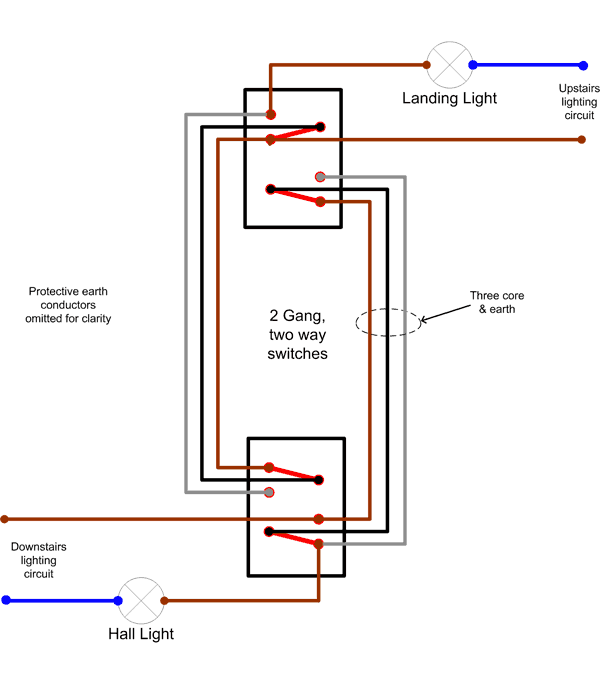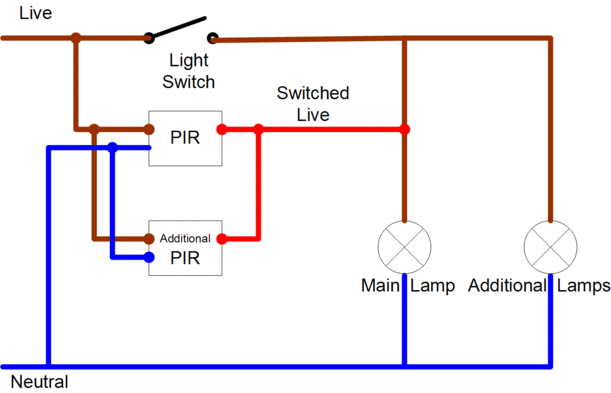Difference between revisions of "2 Way Switching"
(Added new diagram and some more description) |
m (More searchable sub title) |
||
| Line 1: | Line 1: | ||
| − | ''' | + | '''Two way switching''' means having 2 or more switches in different locations to control one circuit. They are wired so that operation of either switch will control the light(s). |
==Standard two way switching circuit== | ==Standard two way switching circuit== | ||
Revision as of 03:46, 7 February 2010
Two way switching means having 2 or more switches in different locations to control one circuit. They are wired so that operation of either switch will control the light(s).
Standard two way switching circuit
To achieve 2 way control the usual single switch is replaced with either of the following circuits:
a ------o------------------------------------o L1
\
O--------------------------------O COM
\
b ------o------------------------------------o L2
switch cable run switch
A typical application is that of being able to switch the hall and landing lights on and off from both upstairs and downstairs. An implementation that allows both lights to be controlled from both locations could look like this:

(in the above example the landing light would be switched off, and the hall light would be on)
Alternative method of Two Way Switching
o------------------------------------o L1
/
a ----O O----- b COM
/
o------------------------------------o L2
switch cable run switch
3 Way Switching
a ------o---------------o o----------------o L1
\ \ /
O---------> X <---------O COM (not connected at X)
/ \ \
b ------o---------------o o----------------o L2
switch cable crossover sw cable switch
Alternative method of 3 Way Switching
o---------------o o----------------o L1
/ \ /
a ----O X O----- b COM
/ \ /
o---------------o o----------------o L2
switch cable crossover sw cable switch
- a & b are the 2 connections that are used in place of the usual single switch (i.e. one connected to live, and the other is the switched live return to the ceiling rose or lamp fitting)
- the switches at each end are 1 pole 2 way switches
- Any number of crossover switches may be added to give 3 or more way switching.
- the cable runs are from one switch location to another
- 3 core & earth cable is usually used for 2 way switch circuits.
Notes
The first example given in each case is the preferred connection method, as it ensures the light is powered from the expected circuit (i.e. that feeding other lights on the same storey). It is also less likely to cause interference problems with electronic systems (the example given in the electrical regulations is inductive hearing loop systems but similar considerations apply to computer networks and other wired systems). Caution: Two way light switches in this switching arrangement will carry live wires from two independent circuits.
The alternative circuits appear to require one less wire but in reality is is usually necessary to return the COM connection at the second switch position to the first switch or the rose or light fitting which typically needs a wire. They are included here as they are often encountered in older wiring. Caution: Something to watch out for on circuits wired in this way, is lamps being powered from unexpected circuits (e.g. upstairs lamp powered from the downstairs circuit and vice versa), also the no uncommon practice of "borrowing" a neutral connection from a circuit other than the one providing the live connection. Needless to say this practice will cause unexpected trips when a modern consumer unit incorporating multiple RCDs or RCBOs is installed.
Carter system
Another 2 way switching method exists and is occasionally encountered. Its called the Carter system (other names are also used).
The lights run off wires A and B. A switch at one end switches wire A between live and neutral. The switch at the other end switches wire B between live and neutral. Thus the lights can see 2 neutrals, 2 lives or one of each.
This approach leaves the supply to the holder live when switched off, creating a very slight risk. It also feeds live and neutral to the poles of a switch, and switches do mechanically fail, creating the risk of a short. For these reasons this method has long been non-compliant, and should not be used.
2 way switching with PIRs
Another common requirement is to a single lamp to e switched by multiple PIR sensors (or for that matter multiple lamps to be switched by one). This can be achieved like this:
Note the light switch in the above diagram can force the lights "on", but will leave them in automatic mode when in its "off" position.
See Also
Keywords
Two way, two way switching, two way switch, intermediate switch, multiple light switches, switching a light from two locations, twin switches, two way wiring, hearing aid compatibility, remote switching
